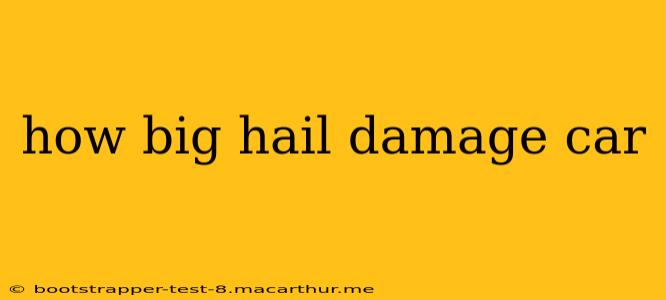How Big Hail Damages a Car: A Comprehensive Guide
Hail damage to a car can range from minor blemishes to catastrophic destruction, all depending on the size and intensity of the hail. Understanding the impact of different hail sizes is crucial for assessing damage and preparing for potential insurance claims. This guide delves into the specifics of hail damage, answering common questions about its severity and impact on your vehicle.
What size hail causes significant car damage?
Significant car damage typically begins with hail larger than one inch in diameter. While smaller hail might cause minor paint chips or dents, hail exceeding an inch can cause significant denting, cracking windshields, and even damage to the car's structural components. The larger the hailstone, the more severe the potential damage. Hailstones the size of golf balls (around 1.75 inches) or larger can cause extensive and costly damage.
How does hail damage a car?
Hailstones act like tiny projectiles, impacting your car with considerable force. The impact energy is transferred to the car's body, resulting in various types of damage:
- Denting: This is the most common type of hail damage. The impact deforms the metal, creating dents that vary in size and depth depending on the hailstone's size and impact velocity.
- Paint damage: Hail can chip or crack the paint, exposing the bare metal to the elements. This can lead to rust and further damage if not addressed promptly.
- Windshield damage: Larger hailstones can crack or shatter windshields.
- Roof and window damage: Hail can also damage the roof, windows, and other glass components of the vehicle.
- Structural damage: In extreme cases, particularly with very large hail, damage can extend to the car's frame and structural components. This requires extensive and costly repairs.
What are the different levels of hail damage?
Hail damage is often categorized based on its severity:
- Minor: Small dents and paint chips that may be easily repaired.
- Moderate: Numerous dents and larger, deeper dents. Paint damage is more extensive.
- Severe: Extensive denting, large deep dents, significant paint damage, and potential damage to windows and other glass components. Structural damage may be present.
- Catastrophic: Extensive damage requiring significant bodywork and potential frame repairs. The car may be deemed a total loss by the insurance company.
How can I assess the hail damage to my car?
A thorough visual inspection is the first step. Check all surfaces of your car carefully, noting the location, size, and depth of any dents or damage. Take photos and videos to document the damage for insurance purposes. If the damage is extensive, consider seeking a professional assessment from a body shop or auto repair facility.
How much does hail damage repair cost?
The cost of hail damage repair varies greatly depending on the extent of the damage. Minor damage can be relatively inexpensive to repair, while severe or catastrophic damage can cost thousands of dollars. Insurance coverage and deductible will influence the out-of-pocket expense.
Can I fix hail damage myself?
Minor dents may be repairable using DIY methods such as PDR (Paintless Dent Repair). However, for more extensive damage, professional repair is typically necessary. Attempting DIY repairs on significant damage can result in further damage or a poor-quality repair.
This information should help you better understand the impact of hail on your car. Remember that prevention is always best – seeking shelter during a hailstorm is the most effective way to protect your vehicle. If you experience hail damage, promptly document it and contact your insurance company.
